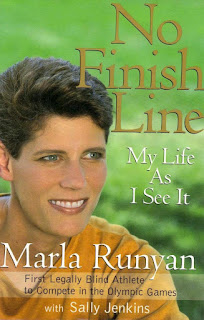(This piece is for my
book titled Pacesetters: Runners Who Informed Me Best and Inspired Me
Most. I am posting an excerpt here each week, this one from May 1989.)
SCHUL DAYS. It was the golden age of
U.S. distance runners in world competition, except we didn’t know it at the
time. You recognize golden ages only after they have ended.
This was the early 1960s, pre-Vietnam. Americans
were supposed to lead the world in all fields, and our distance runners had
lagged behind.
Now they had caught up. Once they knew how to reach
the top of the world, we thought they would stay there. They didn’t.
The golden age for track began in 1962 with Jim
Beatty breaking the indoor four-minute mile barrier for the first time. It
ended in 1967 with Jim Ryun setting the last of his world records.
In that five-year period Tom O’Hara set an indoor
mile record. Three high school milers broke four minutes. Ryun and Gerry
Lindgren made an Olympic team as teenagers.
As quickly as this success had come, it would wane.
Success would shift to the roads, where Frank Shorter won his Olympic Marathon,
Alberto Salazar set a disputed world marathon record, and Bill Rodgers won
repeatedly at Boston and New York City.
Mary Slaney and Joan Samuelson would make the early
1980s a golden age for U.S. women. But this country’s trackmen would never be
the same after 1962-67.
None would set an outdoor world record. None one
would win an Olympic or World Championships race longer than 800 meters on the
track.
The golden age for U.S. trackmen peaked in October
1964 at the Tokyo Olympics. They won both the 5000 and 10,000 there, each for
the first and still only time.
You know the 10,000 winner, Billy Mills. His story
became a movie script, and he still appears on a hundred or more podiums a year
to describe his Tokyo race in person.
You might not know the 5000 winner. A national
hotel chain didn’t remember him last year. When Olympic promotion featured a
display board listing “all” the American gold medalists, the name Bob Schul was
missing.
That’s sadly ironic, because Schul remains the most
active link to the golden age. He hasn’t made a movie or published a book, and
rarely goes onstage. But he stays busy in less public ways.
He races well but not spectacularly in his 50s. He
owns two running stores in the Dayton, Ohio, area.
But mostly he coaches. He continues the teachings
of a coach who helped inspire the golden age.
Hungarian Mihaly Igloi defected to this country and
then convinced Americans that they could run with the world’s best. Two of his
early believers were runners named Beatty and Schul.
Igloi’s speed-based, track-bound, coach-controlled
methods fell out of favor in the late 1960s, replaced by self-guided road
training. Coincidentally or not, the golden age ended at about the same time.
Bob Schul remains a true believer in what worked
for him. His runners train four days a week on the track, with the coach
watching them as closely as Igloi watched Schul.
I traveled to Dayton this April and came away disappointed.
Not with the event that took me there, but with not meeting Schul.
We were due to meet for the first time, but Bob
couldn’t make the scheduled dinner. He relayed his apology, explaining that it
was his busiest coaching season.
He’d just returned from taking Ohio’s team to the
Ekiden Relays in New York City. This weekend he juggled workouts of the Bob
Schul Racing Team (whose members, ranging from elite to midpack, pay him a
small fee to be coached) and those of a high school team he started coaching
this year.
Maybe it’s symbolic that Bob Schul remains only a
name with a set of facts to me 25 years after Tokyo. He is still an invisible
man to most Americans, and that’s a shame.
But if Schul feels overlooked, he doesn’t have time
to dwell on it. He’s too busy preparing his runners for the golden ages that
count most: their own.
UPDATE. The years since the Tokyo
Games have more than doubled since this piece first appeared. Bob Schul remains
the last American, man or woman, to win an Olympic race of than four laps around
the track.
Schul was inducted into the National Track and
Field Hall of Fame in 1991. He published his autobiography, In the Long Run, in 2000. I finally met
him in 2008, when he came to Eugene as a special guest at the Olympic Trials.
[Many
books of mine, old and recent, are now available in two different formats: in
print and as ebooks from Amazon.com. Latest released was Miles to Go. Other
titles: Going Far, Home Runs, Joe’s Journal, Joe’s Team, Learning to Walk, Long
Run Solution, Long Slow Distance, Pacesetters, Run Right Now, Run Right Now
Training Log, See How We Run, and Starting Lines, plus Rich Englehart’s book
about me, Slow Joe.]



